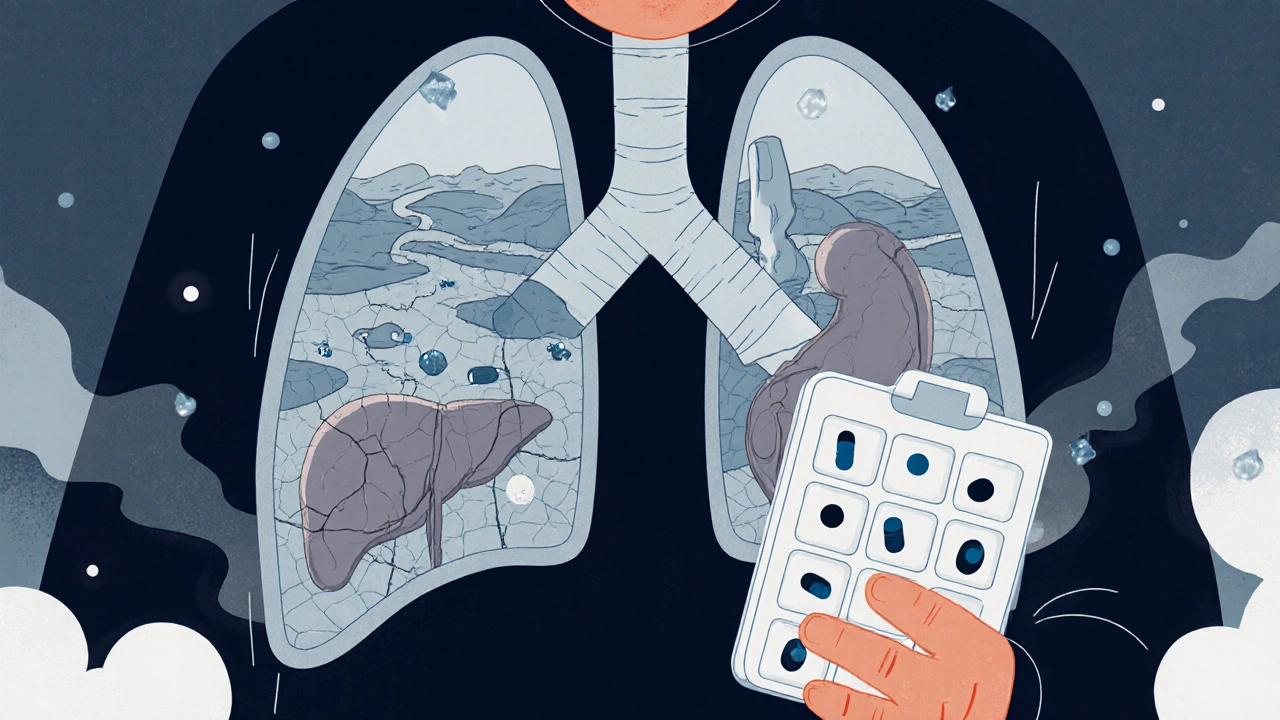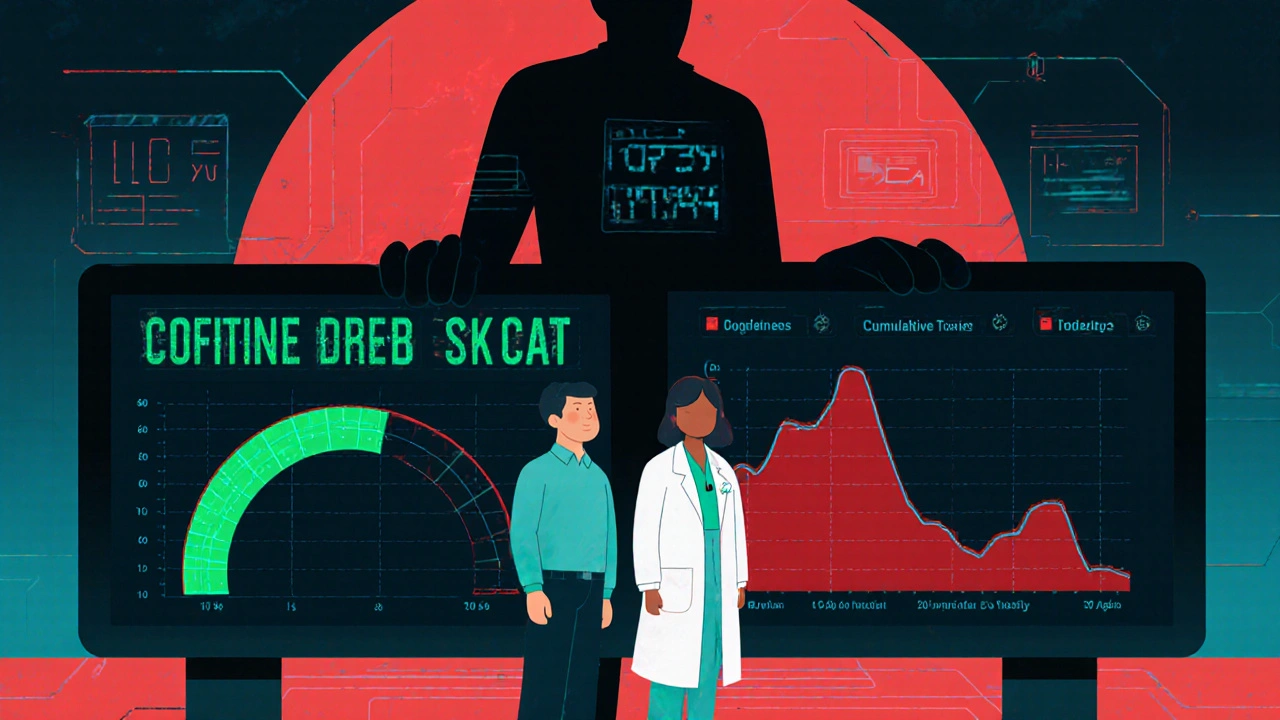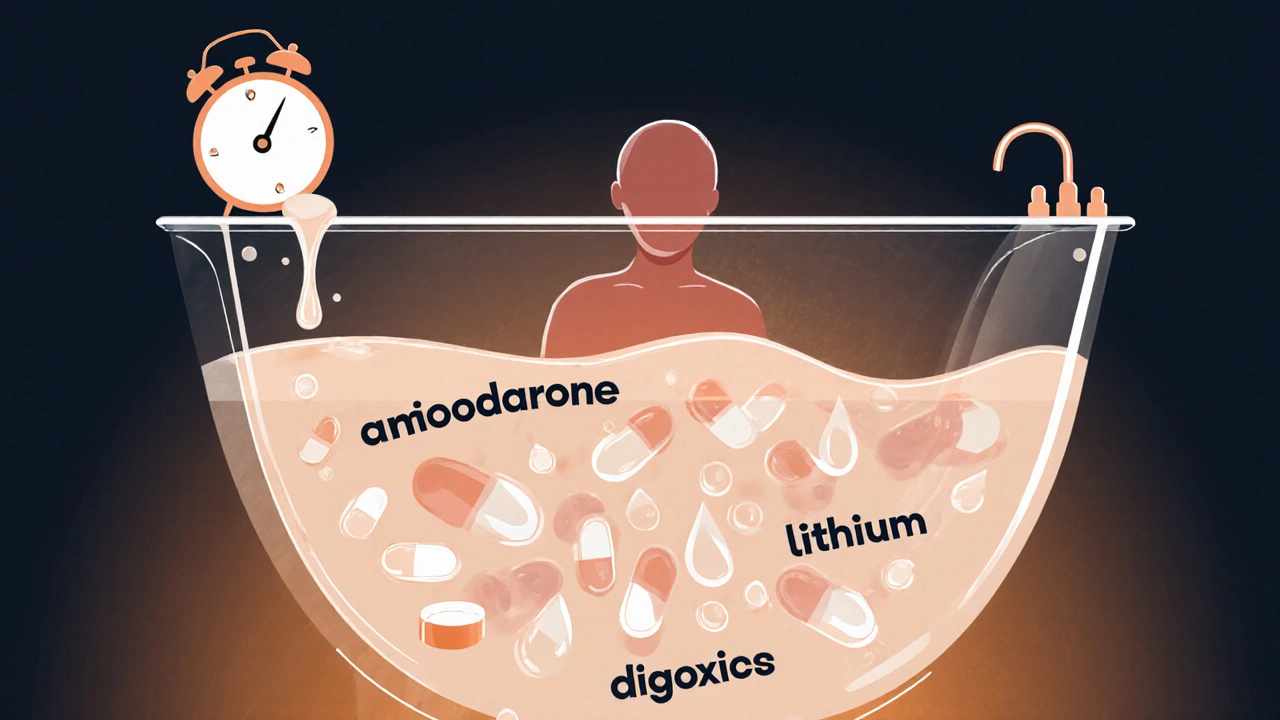Cumulative Drug Toxicity Calculator
Cumulative drug toxicity happens when medications build up in your body over time. This calculator helps you estimate how much a drug accumulates based on your dose and the drug's half-life. Know your body's drug levels before symptoms appear.
Cumulative Drug Accumulation Results
This shows the estimated amount of medication in your system after different time periods. Important: These are estimates only. Consult your doctor for actual medical advice.
After 1 Day
After 30 Days
What these numbers mean: When the amount in your system approaches 100% of the dose (e.g., taking 100mg daily), you're at increased risk of cumulative toxicity. For medications with long half-lives (over 24 hours), accumulation can become significant within weeks.
Key Takeaways
- Tip Medications with half-lives longer than 24 hours are most likely to accumulate.
- Tip Fat-soluble drugs (like some antidepressants) accumulate more easily in body fat.
- Tip Regular blood tests (therapeutic drug monitoring) are essential for drugs with high accumulation risk.
Most people think of side effects as something that happens right after you take a pill. Maybe you get a little dizzy, or your stomach feels off. But what if the worst effects don’t show up until months-or even years-later? That’s cumulative drug toxicity, and it’s quietly affecting millions of people on long-term medications.
What Is Cumulative Drug Toxicity?
Cumulative drug toxicity isn’t a sudden reaction. It’s the slow build-up of a drug in your body over time. Think of it like filling a bathtub with the drain half-closed. The water keeps coming in, but it doesn’t drain out fast enough. Eventually, the tub overflows. That’s what happens with certain medications: your body absorbs them faster than it can break them down or flush them out.This isn’t rare. In fact, about 68% of adverse drug reactions in older adults are linked to this slow accumulation, according to the Journal of the National Cancer Institute. Drugs like amiodarone, digoxin, lithium, and certain chemotherapy agents are especially known for this. Even common supplements like vitamin A or D can build up to dangerous levels if taken daily for years.
It’s not about taking too much at once. It’s about taking the right dose, over and over, until your body can’t keep up. The key is half-life-the time it takes for half the drug to leave your system. If a drug has a half-life longer than 24 hours, it’s more likely to pile up. Fat-soluble drugs, like some antidepressants and heart medications, get stored in body fat and can stay in your system for months. Heavy metals like lead or mercury, even in tiny amounts from the environment, can also build up over time.
Why It’s Hard to Spot
The biggest problem with cumulative toxicity is that it hides. You take your medication every day. You feel fine. Your blood tests look normal. So you keep going. But inside your body, the drug is slowly accumulating. By the time symptoms appear, the damage might already be done.One oncologist shared a case on Reddit where a patient on amiodarone developed severe lung scarring after taking a cumulative dose over 600 grams. At every check-up, blood levels were within the normal range. But those normal levels didn’t tell the whole story. The drug had been building up in the lungs for years, and the damage was irreversible by the time it showed up.
Doctors often miss this because they’re trained to look for acute reactions-things that happen right after a dose. But cumulative toxicity is like a silent timer. It ticks away unnoticed until it goes off. That’s why patients often say, “I’ve been taking this for ten years and never had a problem-why now?”
Who’s at Risk?
Anyone on long-term medication could be at risk, but some groups are more vulnerable:- Older adults: Liver and kidney function slow down with age. The American Geriatrics Society Beers Criteria lists 34 medications with high cumulative risk for people over 65.
- People with liver or kidney disease: If your organs can’t process or remove drugs efficiently, levels build up faster. Studies show impaired function can reduce clearance by 30-50%.
- Patients on multiple medications: Drug interactions can slow metabolism. For example, some antibiotics block the enzymes that break down heart drugs, causing them to linger longer.
- People on chemotherapy or long-term immunosuppressants: Cancer drugs like doxorubicin have strict lifetime dose limits-450 mg/m²-to avoid heart damage. Exceed that, and the risk of permanent heart failure jumps.
It’s not just prescription drugs. Over-the-counter painkillers like acetaminophen, taken daily for chronic pain, can cause liver damage over time. Even NSAIDs like ibuprofen, when used daily for arthritis, can lead to kidney injury that shows up years later.

How Doctors Track It
Therapeutic drug monitoring (TDM) is the main tool doctors use. That means regularly checking blood levels of certain drugs to make sure they’re not creeping too high. It’s standard for drugs like digoxin, lithium, and aminoglycosides. But TDM isn’t perfect.For one, not all drugs have reliable blood tests. Amiodarone, for example, doesn’t have a clear blood level that predicts toxicity. The real danger comes from total lifetime dose, which isn’t always tracked. And even when it is, patients often forget appointments or skip lab work. A Medscape survey found that 82% of doctors blame poor adherence to monitoring as a major reason cumulative toxicity goes unnoticed.
Some clinics are starting to use digital tools. One rheumatology practice reduced methotrexate-related side effects by 37% after implementing a cumulative dose tracker in their electronic records. Oncology centers are using prediction models based on early treatment cycles. If a patient has even mild side effects in cycle one, their risk of severe toxicity by cycle six can jump from 20% to over 65%.
What You Can Do
You don’t have to wait for a crisis. Here’s how to protect yourself:- Know your meds. Ask your doctor: “Is this drug known to build up in the body?” If it is, ask how often you need blood tests.
- Track your doses. Keep a log-paper or app-of every time you take a long-term medication. Note the date, dose, and any new symptoms.
- Don’t skip labs. If your doctor orders a blood test to check drug levels, go. It’s not a formality-it’s a safety check.
- Review your meds yearly. Ask your pharmacist or doctor: “Do I still need all of these?” Sometimes, drugs are prescribed for a short period but kept on auto-pilot for years.
- Watch for subtle changes. Fatigue, memory issues, tingling in hands or feet, unexplained weight gain, or shortness of breath could be early signs of accumulation. Don’t write them off as “just aging.”
There’s no magic pill to reverse cumulative damage. Prevention is the only real defense. And that starts with awareness.

What’s Changing in Medicine
The medical world is catching up. In 2024, the European Medicines Agency made cumulative toxicity assessments mandatory for all new drugs meant for long-term use. The FDA now requires cumulative dose warnings on 78% of new cancer drugs-up from just over half in 2017.Hospitals are investing in tech. The global market for therapeutic drug monitoring is expected to hit $4.7 billion by 2028. AI models are being tested to predict individual risk by analyzing 27 different factors-genetics, age, organ function, other meds, even diet. Early results show 82% accuracy in predicting who’s likely to develop toxicity.
But the biggest barrier isn’t science-it’s systems. Only 38% of electronic health records in the U.S. can automatically track cumulative doses. That means most doctors are still doing it by hand, using paper charts or memory. It’s outdated. And dangerous.
The Real Cost
Cumulative toxicity isn’t just a health issue-it’s a financial one. In the U.S. alone, it leads to $1.2 billion in extra healthcare costs each year from hospitalizations, emergency visits, and treatment delays. It accounts for 15% of cancer treatments being stopped early, and 22% of dose reductions.One study found that pharmacist-led monitoring programs reduced hospital admissions for drug toxicity by 29% across 45 health systems. That’s not just saving lives-it’s saving money.
But unless patients and doctors work together, progress will be slow. Too many people think, “If it’s not broken, don’t fix it.” But with cumulative toxicity, the damage is already done before you feel it.
Can cumulative drug toxicity be reversed?
Sometimes, yes-if caught early. Stopping the drug can stop further buildup, and your body may slowly clear it out. But if damage has already occurred-like liver scarring, lung fibrosis, or heart muscle injury-it may be permanent. That’s why early detection matters more than treatment.
Do over-the-counter drugs cause cumulative toxicity?
Absolutely. Daily use of acetaminophen (Tylenol) for years can lead to liver damage, even at recommended doses. Long-term NSAID use (like ibuprofen or naproxen) can harm kidneys and increase blood pressure. These aren’t “safe” just because you can buy them without a prescription. They still have cumulative risks.
Why don’t doctors always warn patients about this?
Many don’t realize how common it is. Others assume patients will follow up with labs or that side effects are “normal.” Some drugs lack clear guidelines for cumulative monitoring. But awareness is growing. If you’re on a long-term medication, ask directly: “Could this build up in my body over time?”
Is there a way to test for cumulative drug buildup without blood work?
Not reliably. Blood tests are the gold standard for drugs with known levels, like lithium or digoxin. For others, like amiodarone, doctors rely on symptom tracking, imaging (like chest X-rays for lung damage), and lifetime dose logs. There’s no single test that measures total drug burden yet-but research is moving in that direction.
How long does it take for cumulative toxicity to develop?
It varies. For some drugs, like certain chemotherapy agents, toxicity can show up after just a few months. For others, like amiodarone or vitamin A, it can take years. Fat-soluble drugs stored in body fat can take 50 to 200 days to clear just half the dose. That’s why symptoms often appear after 1-5 years of daily use.
Final Thoughts
Cumulative drug toxicity isn’t a myth. It’s a quiet, growing problem in modern medicine. We’re living longer. We’re taking more medications for longer. And we’re not always tracking the hidden toll.It’s not about avoiding medicine. It’s about using it wisely. If you’re on a daily pill for months or years, don’t assume it’s harmless just because you feel fine. Ask questions. Track your doses. Show up for your labs. Your future self will thank you.


Comments (17)
Abhay Chitnis
November 23, 2025 AT 13:19bro this is wild 😳 i've been taking ibuprofen daily for my back for 3 years... you're telling me i'm slowly killing my kidneys??
Brandon Benzi
November 23, 2025 AT 23:15Another liberal medical fear-mongering piece. People die from not taking meds, not from taking them. Wake up.
Robert Spiece
November 25, 2025 AT 00:18Ah yes, the classic "your body is a bathtub" metaphor. Cute. But here's the real truth: medicine has always been a gamble. We just got better at pretending we're in control. The truth? We're just throwing chemicals into a black box and hoping the numbers don't spike. And now we're surprised when the box explodes? Classic.
Vivian Quinones
November 25, 2025 AT 09:23I'm so tired of this. America is the best country in the world and we don't need this fear crap. Just take your pills and stop being weak.
Eric Pelletier
November 26, 2025 AT 16:14Actually, the half-life concept is oversimplified here. Pharmacokinetics vary wildly based on CYP450 polymorphisms, renal clearance rates, and protein binding. For example, amiodarone’s terminal half-life is 40-55 days due to high lipophilicity and adipose tissue sequestration. Most clinicians don't track cumulative dose because the data isn't standardized-there's no FDA-mandated "total lifetime exposure" field in EHRs. We're flying blind.
Marshall Pope
November 26, 2025 AT 19:22i never knew this. i take 2 tylenol every night for sleep. guess i gotta start writing it down. thanks for the heads up
Nonie Rebollido
November 27, 2025 AT 03:26this makes me think of my grandma... she took lithium for 20 years and never had a problem. but then one day she just... slowed down. we thought it was aging. turns out her kidneys were fried. 😔
Agha Nugraha
November 27, 2025 AT 06:13Interesting read. In India, we don't track this at all. People just refill prescriptions for years. No labs, no follow-ups. Maybe this needs to be global awareness.
Andy Smith
November 28, 2025 AT 22:34I appreciate the depth of this article, but I’d like to add: therapeutic drug monitoring (TDM) is only as good as the clinical context. For drugs like lithium, the therapeutic window is narrow (0.6–1.2 mmol/L), but even within that range, chronic toxicity can manifest as tremor, cognitive fog, or polyuria-symptoms easily dismissed as "normal aging." The real gap isn’t technology; it’s physician education and patient communication.
Rekha Tiwari
November 30, 2025 AT 20:21OMG this is so important!! 🙏 I work in a pharmacy and I see people on 10+ meds for decades. No one ever asks if they still need them. Please, please, please talk to your pharmacist!! 💊❤️
Leah Beazy
December 1, 2025 AT 13:24I used to think "natural" meant safe. Then I found out my mom was taking 2000 IU of vitamin D daily for 15 years. Turns out she had hypercalcemia. We didn’t know until she collapsed. Don’t assume anything. Ask. Always.
Jenna Hobbs
December 1, 2025 AT 18:45This is the kind of article that makes me want to hug my doctor. Seriously. I’ve been on antidepressants for 8 years. I never thought about how they might be sitting in my fat cells like little time bombs. Thank you for shining a light. I’m scheduling my labs tomorrow.
Ophelia Q
December 3, 2025 AT 03:11I had no idea. I’m so glad I read this. I’ve been taking metformin for 12 years and just assumed it was fine. I’m calling my doctor right now. 🙏
Elliott Jackson
December 4, 2025 AT 05:31I’ve been taking statins since I was 35. I feel great. My bloodwork is perfect. So why should I believe some random article that says my liver is slowly turning to mush? I’ve got more important things to worry about than hypothetical toxicity.
McKayla Carda
December 5, 2025 AT 12:22I'm scheduling my labs this week. Thanks for the nudge.
Christopher Ramsbottom-Isherwood
December 6, 2025 AT 14:49You know what’s worse than cumulative toxicity? The pharmaceutical industry pushing lifelong meds for conditions that don’t need them. This article ignores the real culprit: profit-driven medicine.
Stacy Reed
December 7, 2025 AT 07:20I’ve been saying this for years. Everyone’s just on autopilot with their meds. No one questions anything. It’s like we’re all in a cult of pharmaceutical compliance. You think your doctor cares? They’re paid per visit. They don’t want to hear about your 12-year-old prescription.